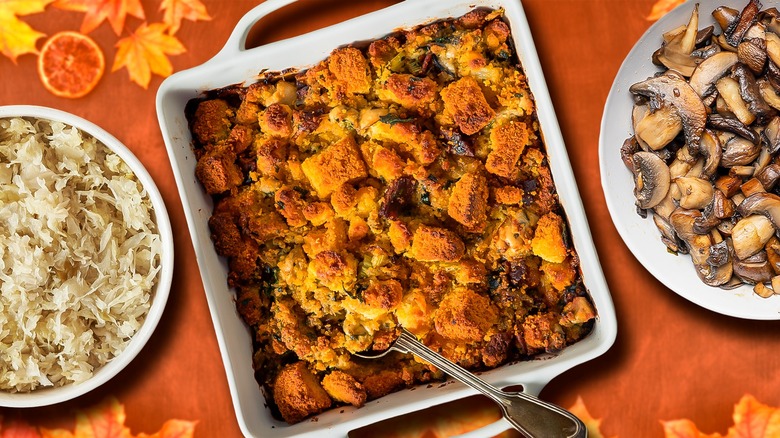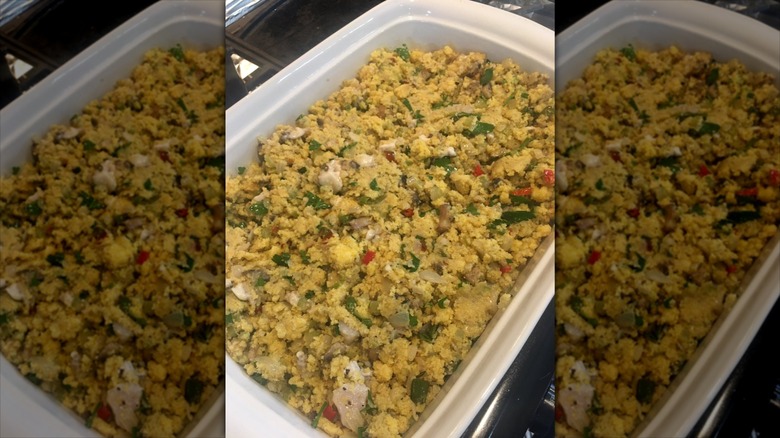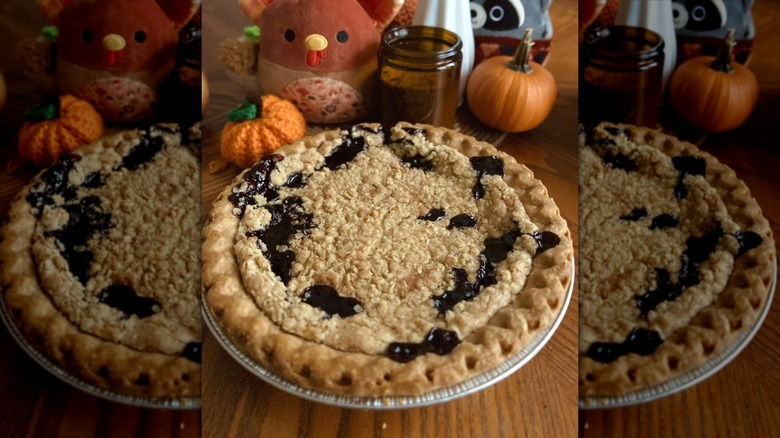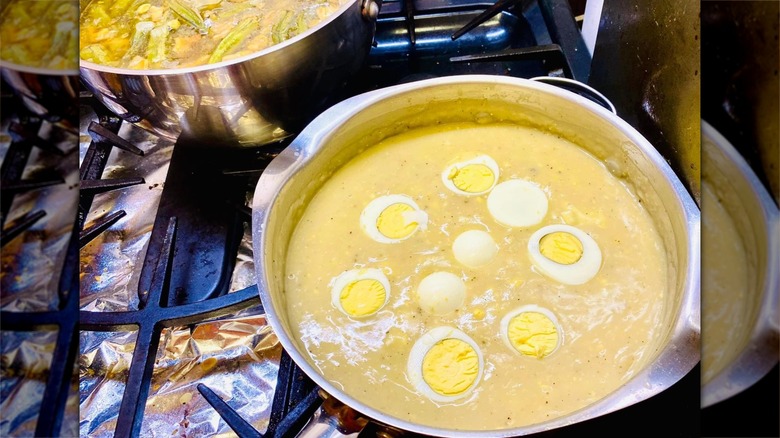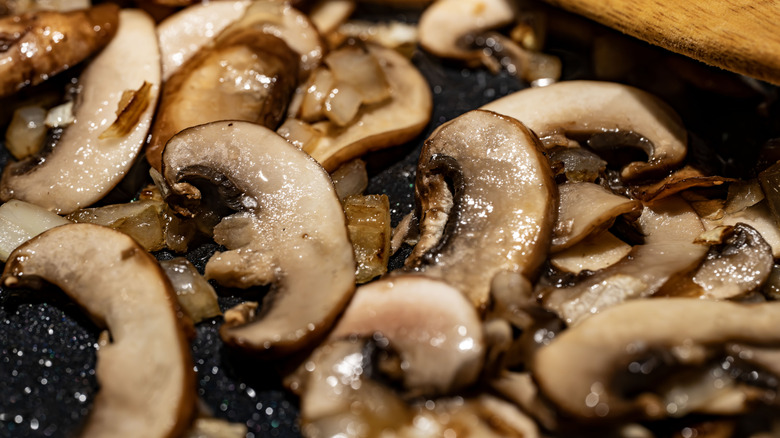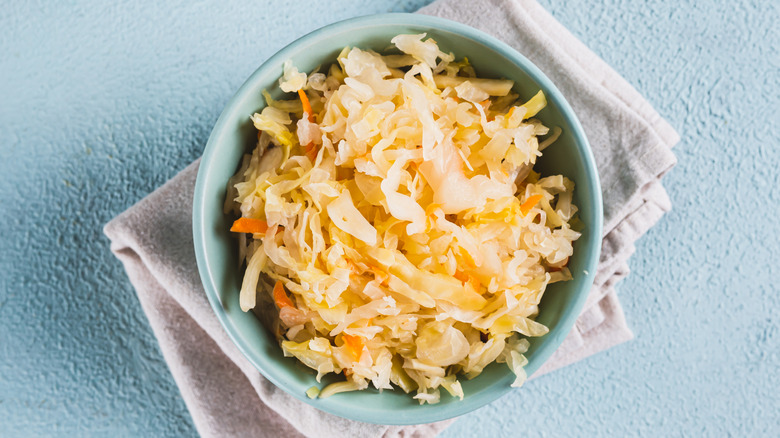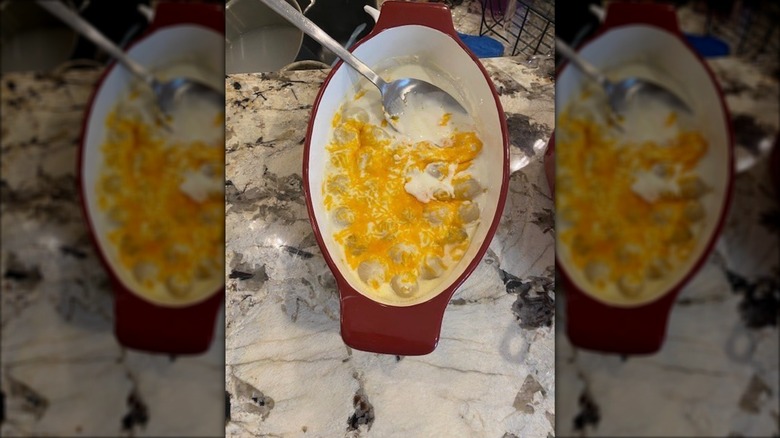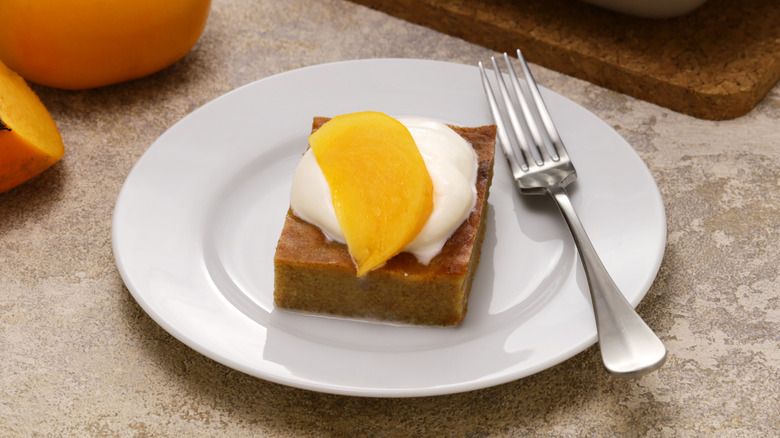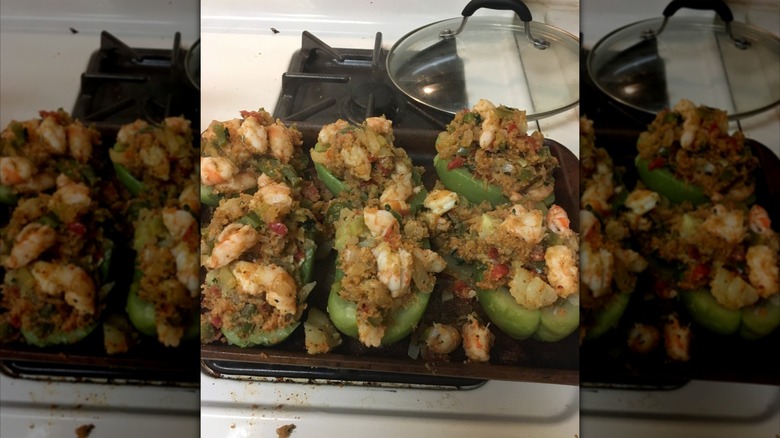13 Thanksgiving Side Dishes That You'll Only Find In Some Parts Of The US
Thanksgiving, at least as it's celebrated today in the U.S., is all about some high-minded concepts. This is a holiday about gratitude, reflection, and history, presented as a time to gather with loved ones and take stock of all the good things in life while thinking about the past and one's predecessors and relatives. Thanksgiving also marks the start of the winter holiday season, a time when all those celebrations are commemorated with an abundance of food.
Not only does good food fuel an equally good time with friends and beloved family members, but it's also a pathway to memories and nostalgia. Almost every person and family across the nation has a bevy of foods that they associate with Thanksgiving in particular. Those dishes offer a bite of history, because so many are tied to a specific city, state, or region, owing to collective tastes or the availability of certain unique ingredients. Such foods are so tied to their point of origin that they're almost unheard of in the rest of the country. Here are the Thanksgiving items that are must-makes in some places, but remain little-known outside of their culinary homes.
Oyster stuffing
There's an ongoing debate about whether or not people should really be eating raw oysters, but that doesn't come into play at Thanksgiving tables throughout New England — as well as some Southern states — where you will often find a traditional and very local side dish. Stuffing, or dressing as it's also known, comes in a variety of forms, including mix-based dishes like Stove Top, or homemade from bread crumbs or chunks of cornbread.
Whether it's stuffed into the turkey or served alongside it, oyster stuffing (or dressing) has been a northeastern tradition since at least the 17th century, when it was first mentioned in a cookbook. Oysters were a major food source for New Englanders, as the coastal waters in the area were chock-full of them up until the early 20th century, when populations were decimated by pollution and overconsumption.
While a sprinkling of oysters is more expensive than it used to be, they're still used to bolster a stuffing each Thanksgiving in some areas. The dressing itself is otherwise fairly standard, with bread crumbs, celery, and herbs and spices cooked together until soft, with the addition of fat and potentially mushrooms and chestnuts.
Wild rice hotdish
Every state has its own legendary casserole, but only some have hotdish. There's a difference between casserole and hotdish in that the latter is a one-pot meal, made with a starch, creamy binders like soup, canned vegetables, a protein source, and often cheese, all combined into a single deep pan and baked. Hotdish is part of the cultural fabric of Minnesota. In the Gopher State, potlucks or church and community events may feature various examples of hotdish, but there's one variety in particular that's commonly reserved for Thanksgiving and other holiday dinners.
Wild rice is everywhere in Minnesota, and the truth is that it's not even rice. It's actually a type of grass that grows in lakes, and it's collected in Minnesota's many waterways in the summer. A fair amount of that harvest goes into the Thanksgiving wild rice hotdish. As it's a casserole, it's an everything-goes-in-at-once type affair, with meat — such as pork sausage or ground beef — and onions, mushrooms, celery, cream of chicken soup, and chicken broth all doing their part to cook and meld with the wild rice. This hotdish is also a readily adaptable dish, with stuffing and turkey fitting in nicely with all the wild rice and vegetables.
Concord grape pie
Several desserts that date to the Great Depression deserve a comeback, but grape pie never really went away for residents and visitors to New York state and other parts of New England. Upstate New York produces a hefty portion of deeply purple and very juicy Concord grapes, and those serve as the basis for a pie that can easily be made with that extra Thanksgiving pie crust one might otherwise throw out.
It caught on during the Depression because it's a simple and inexpensive dessert, partly because at the time, grapes were a plentiful (and locally cheap) crop in the northeastern U.S., and partly because the filling doesn't call for much besides pantry staples such as sugar, salt, vanilla, and cornstarch. The dessert turns out like so many other fruit pies — all soft, gooey, and sweet on the inside and with a flaky and buttery crust — making it worthy of a spot alongside other, more common Thanksgiving options, such as apple and pumpkin pie.
Turkey giblet gravy with eggs
In its simplest form, gravy is simply the mixture of fat, salt, juices, and tiny meaty bits that drip off a piece of meat or a bird during cooking or roasting. Such an origin will lead to lots of different kinds of gravy. A lot of people like their gravy — particularly the turkey gravy presented in a little ceramic boat on Thanksgiving — to be smooth and lump-free, which is probably why easy-to-prepare powdered gravy has become so popular. But in the South, cooks aren't afraid of a gravy with a little heft to it. Take the white gravy loaded with sausage chunks used for the classic dish of biscuits and gravy, or the lesser-known dinner-style concoction made with giblets and hard-boiled eggs.
Made from and served with turkey when the grand bird is the focus of the feast, Southern-style egg gravy is more likely to be found during Thanksgiving dinner in the South than anywhere else. It's a fairly standard gravy, prepared with turkey fat and drippings along with flour, salt, and pepper, and maybe some chopped shallots, plus giblets. Mixed in before serving is a whole hard-boiled egg or two, often finely sliced to ensure even distribution.
Sourdough stuffing
There are probably almost as many different stuffing or dressing recipes as there are households or families that use them each and every Thanksgiving, as they have for generations. The idea of stale bread mixed with herbs, turkey fat, and juices to make a flavorful side dish is a nearly universal holiday dining phenomenon, but the one way it can be the most disparate is the type of starch used. Bread is regional, and so is the stuffing made from it.
Joining cornbread stuffing and boxed, white bread-based stuffing is California's contribution to the Thanksgiving canon: sourdough stuffing. Sourdough is a very old bread made around the world, but it has been embraced by San Francisco as the area's own, on account of how it was made on the fly out of necessity with little resources in the Gold Rush mining camps that sprang up in the late 1840s. It has since become a statewide favorite, with fermented dough-based sourdough bread acting as the key force in California's sourdough stuffing. It's made in the same way and features many of the same favored stuffing ingredients, such as celery, onions, thyme, and sage. This one is just tangier because of its titular inspiration.
Sautéed mushrooms
Mushrooms are everywhere in the Pacific Northwest, particularly in Oregon and Washington. The wild-grown ones get foraged in the fall months because that's when the rains are heavy enough to coax them up from the forest floor and other natural terrains. These aren't the white, brown, or portobello mushrooms found at grocery stores around the country. These are meaty, nuanced mushrooms with unique shapes, colors, and flavor profiles, and this class includes morels, chanterelles, and hedgehogs. Those mushrooms form a good part of the cuisine and diet of the Pacific Northwest, particularly in the fall, and right around when Thanksgiving comes around each year. That means that, for many families, mushrooms are a big part of the holiday meal.
One might find mushrooms in many different Thanksgiving dishes, adding a Northwestern spin. Mushrooms may appear in the stuffing, or in gloopy vegetable casseroles alongside green beans, or as part of the gravy used to douse the bird or the mashed potatoes. Mushrooms may even earn a spot of distinction all on their own, sautéed in butter with some fresh fall herbs and served as a side dish.
Sauerkraut
Sauerkraut has plenty of everyday uses. It's great on a hot dog or with a sausage, and it's a key ingredient in a Reuben sandwich, for example. Rarely does one see someone just eating it on its own, which shouldn't be that absurd — sauerkraut is just fermented cabbage, after all. A tangy addition that makes salads extra flavorful, sauerkraut is basically a salad unto itself, which can help explain why it's not odd at all, expected even, to find a big bowl of sauerkraut placed on the table as part of a Thanksgiving spread in the greater Baltimore area.
That sauerkraut doesn't enjoy its position among the turkey, potatoes, and cranberries because it's not necessarily a condiment or topping for some other dish — it's entirely its own thing. Sauerkraut is popular in Germany, and when Germans emigrated in large numbers to Baltimore in the late 19th century, around the time that Thanksgiving became a national holiday in the U.S., the food was logically included. Before long, non-German Baltimore residents took up the practice, too.
Frog eye salad
Centuries after it settled in what was then the far American West, members of the LDS Church continue to live in that region in concentrated numbers. Along with Utah, adherents reside in large numbers in surrounding states like Nevada and Colorado, and it's in those places where LDS food culture thrives.
Encouraged to raise large families and to eschew coffee, tea, and alcohol, LDS members prepare and eat a lot of broadly appealing food, plenty of which contains a lot of sugar. There are lots of casseroles shared among families and others in the community, along with sweet, creamy desserts that also work as side dishes. One such item that worked its way through family meal rotations and potluck meals to a place of prominence at Thanksgiving dinners is frog eye salad.
Similar to ambrosia or fruit salads built from a mixture of canned fruits and whipped cream or Cool Whip, frog eye salad doesn't contain frogs or eyes, but it does contain a lot of crowd-pleasing sweetness not seen much at Thanksgiving before the pie course. Custard or vanilla pudding is mixed with whipped cream (or Cool Whip), a variety of canned fruits, mini marshmallows, and shredded coconut. The "eyes" in the salad come in the form of tiny acini di pepe pasta, which supposedly resemble reptile eyes.
Creamed onions
The average Thanksgiving feast probably isn't lacking in either heavily creamy dishes or ones starring vegetables cooked until they're extremely soft. In New England, as well as some parts of the Midwest and the South, countless households have symbolically said that all those dairy-laden potato items and squishy veggie casseroles aren't nearly enough, because that's the homeland of a regional Thanksgiving classic called creamed onions. The onions themselves aren't made into a creamy substance but rather adorned with a rich sauce akin to a Bechamel.
Creamed onions start with a few pounds of pearl onions, however one might find them – fresh, canned, or jarred, just so long as they retain their distinctive bite and density. Some recipes call for the onions to be cooked on their own in water or stock until they're soft, with a portion being pureed and heated up with plenty of salt and pepper, and spices like bay leaves and nutmeg, which season a sauce made from flour, butter, milk, and cream. The sauce goes on the onions, and it's either served that way or baked for a while.
Persimmon pudding
When one comes across persimmons in a grocery store, it's most likely that those are Fuyu persimmons, grown throughout Asia and other places with warm climates, boasting a strong texture and slightly bitter taste. There are also wild American persimmons, which are very sweet and good in desserts, but they grow in many places in the Eastern and Midwestern United States, including Indiana. The Midwestern state has pushed to make the persimmon its state fruit, with locals competing for the best in show prize at the annual Mitchell Persimmon Festival. Unsurprisingly, Indiana has spawned an array of persimmon recipes, with cooks drawing from enduring family traditions to make things like persimmon pudding.
Persimmon pudding isn't a pudding in the usual American sense. Instead, it's more of a spongey, eggy cake. Frequently served on Thanksgiving in Indiana, persimmon pudding is made with seedless, pureed fruit as well as eggs, sugar, flour, and milk. The autumnal combination of nutmeg, vanilla, and cinnamon balances out the sweetness.
Pumpkin empanadas
Various kinds of squash historically play a role in Thanksgiving dinners across the land because they're so seasonal. Autumn is the time when such vegetables provide an abundant harvest, which explains why the big fall holiday of Thanksgiving so prominently features squash dishes. While pumpkin pie is a national phenomenon, regional ideas abound. Along the Mexico border in the American Southwest, particularly New Mexico, diners are likely to find pumpkin empanadas as part of the Thanksgiving spread.
Empanadas are a pocket-style sandwich that originates in Spain and Portugal. Emigrants to the Southwest brought empanadas with them, and it's a versatile food that can handle a variety of stuffings, including the unofficial squash of November, pumpkin. Served as a snack or dessert at Thanksgiving, and throughout the fall, pumpkin empanadas are reminiscent of pumpkin pie, in that they're made with a pumpkin spiced with cinnamon and cloves, as well as a type of brown sugar called piloncillo. That's all pureed and placed into a small parcel of dough that's formed into a half-moon and then baked.
Shrimp mirlitons
The fall squash of choice and convenience in Louisiana, home of American Creole and Cajun cooking, is the mirliton. Sold and grown in other parts of the United States, mirlitons are also known as chayotes or vegetable pears, on account of their shape and green-colored skin. They've got a lot of mirlitons in and around the state of Louisiana, and cooks there mince and mash the vegetable with another significant area staple — shrimp caught in the nearby Gulf of Mexico — to make a dish closely associated with a Louisiana Thanksgiving dinner.
Shrimp mirlitons rely on a base of mirlitons. After the mirlitons are cooked until soft, well-drained, and cooled, the flesh is mixed with frequently employed Cajun and Creole ingredients, including big pieces of chopped shrimp, onions, green peppers, garlic, butter, and herbs and spices. The finished concoction is either served like a casserole or as individual servings, carefully spooned back into the shells of the mirlitons used.
Potato filling
No matter where one eats a giant American Thanksgiving dinner, it's almost a guarantee that there will be some kind of potato dish as well as a stuffing. While taters and bread are each represented in many old-school Thanksgiving staples rarely found on tables today, they are, by and large, prepared and served separately to maximize starch consumption. But not in the Pennsylvania Dutch community or in the areas surrounding that culture's historical settlement point in the northeastern United States.
That region is home to a Thanksgiving side dish called potato filling. It's likewise made with both potatoes and filling, more commonly known as stuffing or dressing. Sometimes also called Amish potato filling, it's a hot, carbohydrate-laden comfort food that combines the best of mashed potatoes and stuffing. Often made early to allow the flavors to meld together, home cooks prepare made-from-scratch mashed potatoes and bread crumb-based dressing as they would, but all in one serving vessel.
